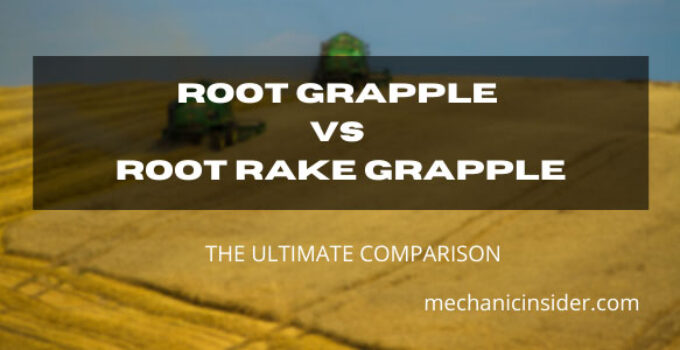Cleaning out your backyard is truly an agonizing task. It gets even worse when the grapple doesn’t fit your skid steer for that particular purpose.
In this kind of scenario, you might want to explore the collection of various attachments available for a skid steer. Moreover, as most of these attachments have a universal mounting system, these can go with any kind of skid steer.
Unless you have a specific application in mind, differentiating between root grapple vs. root rake grapple will be a difficult task. However, the root grapple functions well when carrying logs and stuff, whereas the root rake performs better when transporting heavy materials.
Both grapples are incredibly durable when you know how to use them. Also, if you do your research correctly, you can pick the best one from the market. You can be relieved with your purchase as these devices are highly reliable.
Quick Comparison
Before jumping right into the in-depth review, here’s a refresher on the key differences. A quick glance will clarify the critical factors for you. But we urge you to go through the later sections for a more informed discussion.
|
Category |
Root Grapple |
Root Rake Grapple |
|
Intended Purpose |
Collecting logs and such |
Picking heavy materials |
|
Structure |
Narrow |
Wide |
|
Feel |
Feels heavier on the tractor |
Feels comparatively lighter on the tractor |
|
Visibility |
Ensures better visibility |
Visibility gets hampered because of more number of teeth |
|
Cylinder |
Single cylinder |
Double cylinder |
What Is A Root Grapple?
A root grapple is a necessary attachment for a skid steer. If you want to carry heavy material like trees or logs, then a root grapple should be your choice. A root grapple’s powerful jaws can pick up huge loads and transport them from one to place the other.
Here are some additional features that distinguish a root grapple:
Jaws
Root grapples have two jaws. One on the top and the other at the bottom. The bottom jaw has flat teeth, whereas the upper one has more pronged teeth. The contraction and retraction of the jaws enable it to lift and penetrate heavy materials.
A flat bottom jaw is mandatory for the root grapple as it offers optimal stability. Moreover, the upper jaw functions as a penetrator and punctures through the loads, ensuring further balance.
Grip Strength
The clamping strength of root grapples mainly comes from powerful hydraulic cylinders. The hose springs installed with the grapple prevent the cylinders from taking any damage.
In addition, the cylinders have a stopping mechanism that prevents them from hyperextension or getting stuck in a particular position.
Application
Root grapples are the perfect tool if you want to use them for scooping up materials or carrying rocks, logs, and so on. Moreover, root grapples offer even better stability than a bucket. You can even use these grapples for pulling stuff out of the ground like dead roots of trees.
For example, the bamboo splinters and seeds into the soil. But if you got a root grapple, you can use it to penetrate the soil and take the tree out with all of its roots. This will entirely remove the place and leave it all clear.
What Is A Root Rake Grapple?
A root rake is another extension that’s used in a skid steer. The prolonged teeth of the root rake turn it into the perfect tool for raking. It’s quite a heavy-duty attachment and is also used in land clearance and forestry.
Some features that set apart a root rake grapple are as follows:
Functionality
When trees get uprooted for landscaping purposes, a root rake is brought in because it’s the ideal tool to clear the area up in an instance. Because of this, your work doesn’t get hampered, and you can continue without any fuss. Raking is functional on both loose dirt and general soil conditions too.
However, the root rake grapple has a mono functionality that allows the weight to be interchanged with speed and maneuverability. And you can find root rake grapples for compact tractors anywhere near you at very minimal costs.
Teeth
The teeth of the root rake grapple for the tractor are spaced about 12″ apart from each other. This large gap between the teeth allows the soil and dirt to pass through them smoothly. And while doing so, the rake picks up stones and felled trees, which can be troublesome.
You can also find holes between the teeth of the skid steer root rake grapple. These holes allow a more detailed view for the driver, which ensures 100% safety and efficiency. The function of a root rake is essentially the same as the teeth attached to a bucket.
Categorization
Root rakes are mainly categorized based on their teeth or blades. However, these teeth are easily replaceable, thus prolonging the lifetime of the equipment.
Depending on its model, a root rake grapple can either have a bar with the teeth fixed on the bottom of the blade or a frame-style blade. This kind of grapple rake not only clears the junk but also helps in carrying it out and lifting it into a garbage truck for hauling it away.
The grapple rake includes so many varieties of sizes and styles that provide exceptional ease of use. Root rake grapples can be attached to small tractors, skid steers, and many other pieces of equipment.
Root Grapple Vs. Root Rake Grapple
Both the root grapple and the root rake grapple do nearly the same jobs. However, the root rake grapple shows a bit more versatility among the two.
The claws of the root rake grapple allow it to rake and lift the loads way above the ground level. This is what distinguishes the root rake grapple from the root grapple.
The most significant factors to consider when distinguishing between the two attachments can be the application, whether to go for more maneuverability or power and stability.
Structure
A distinct difference between root grapple and root rake grapple that’s even visible to the eyes is the shape and form of these attachments. Specifically, a root grapple is generally structured to be in a bit narrower shape than the root rake grapple.
Root grapples have an average length that’s somewhere between 30 to 35 inches, whereas, in terms of a root rake grapple, the length increases up to 65 to 70 inches. Therefore, it’s evident that between root grapple vs. rake grapple, the root rake grapple will obviously cover a wider area and cover better space than the root grapple.
Work Environment
When comparing the two grapples, the environment where you’re working is also a massive factor.
If you intend to do heavy lifts such as felled trees or logs, root grapples should be good enough for you as the jaw’s power of the root grapple can easily pick up the heavy loads and transport them from one place to the other with ease.
On the other hand, if you’re clearing out dead trees from an area usually much lighter than giant trees and logs, you can prefer using root rake grapples.
That’s because the root rake grapple for Kubota tractors is easier to steer amongst root grapple versus brush grapple. This will surely optimize your overall work speed and efficiency when executing the task.
Application
When selecting a grapple, you must consider the job you’re assigned for. If the job requires you to simply clear some items, then either grapple should suffice.
However, if the job requires you to frequently carry and lift materials into garbage trucks or other hauling vehicles, the root rake grapple is the best one.
This is a massive advantage because the product has been engineered solely to optimize the ” Raking ” function. So, this means the unnecessary weight of the grapple has been left behind to increase the ability of maneuvering, which offers efficient movement.
However, the root grapple provides a multi-purpose functionality between root grapple vs. rock grapple. That’s because it allows it to be useful for various applications.
Although the accuracy in handling is somewhat lost because of the increased weight, it’s supplemented with the massive increase in clamping power of the grapple jaws.
Height
In the matter of height, the root grapple wins the crown as these grapples are significantly taller than the other ones. Moreover, a root grapple comes with increased height, but the width is cut short to adjust to that. As a result, a root grapple shows more versatility in cutting logs placed above ground level.
You can find root rake grapples for sale that can be around 5 to 6 feet wider. However, the height must be cut short to adjust to the excess width. That’s why this particular device comes with a smaller size compared to the root grapple.
But there’s a plus point of not dealing with so much height for all root rake grapples. The reduced height offers better control and helps these machines pick up heavy materials with increased proficiency.
Weight
A root grapple generally feels heavier on the tractor after installing it. After installation, when you try to maneuver the grapple, you’ll notice that the root grapple feels insanely heavy. The sole reason is the taller height of the root grapple.
You might think that the root grapple is much lighter than the root rake grapple, but then how come it feels so heavy?
The answer lies in the geometry or the shape of the root grapple. Although the root rake grapple weighs a lot more than a root grapple, height plays a significant part in increasing the apparent weight of the grapple.
In the case of the root rake grapple, its parallel construction allows the weight of the grapple to be distributed evenly throughout the tractor, and it feels less weight despite having more weight than the root grapple.
Visibility
A root grapple will guarantee better visibility when compared between a root grapple vs. debris grapple. The reason is that a root grapple has lesser and smaller-sized teeth compared to root rake grapples.
So the vision doesn’t get blocked due to the oversized teeth of the grapple. Therefore, a root grapple delivers better visibility.
On the contrary, a root rake grapple will have more teeth than a root grapple. Although the increased number of teeth makes moving through the soil and dirt easier, so many teeth make it a lot more difficult for the driver to see clearly.
But if you’re only considering the intended purpose, the matter of visibility shouldn’t create a problem.
Versatility
The versatility of a grapple is an essential factor when choosing one. By versatility, we mean the overall situations where you’ll use these devices.
As a root grapple has fewer teeth, it performs better when it’s assigned for picking up logs and stuff. On the contrary, with its multi-teeth structure, a wicked root rake grapple will help you out in multiple scenarios, like punching through heavy loads. You’ll also find a root rake grapple for the excavator, as these also do a pretty decent job.
Because of this, when versatility is the deciding factor, a root rake grapple will definitely ensure better productivity.
Cylinders
Most root grapples have a single cylinder. On the other hand, root rake grapples are powered with a dual cylinder.
It’s understandable because root rake grapples have to carry out heavy loads. So, they require that extra push. That’s where the extra cylinder comes into play for root rake grapples.
But it’s also a fact that the root grapple usually has a larger single-cylinder, yet the root rake grapple consists of 2 smaller or medium-sized ones.
Final Words
To be honest, a root rake grapple does a tremendous job in terms of raking down the ground. But sadly, a root rake grapple won’t be enough if your job requires you to collect larger loads from the ground. That’s where the root grapple will serve you the best.
Therefore, as long as you know how does a root grapple work, the choice between root grapple vs. root rake grapple should only be based on the intended purpose of the device!



